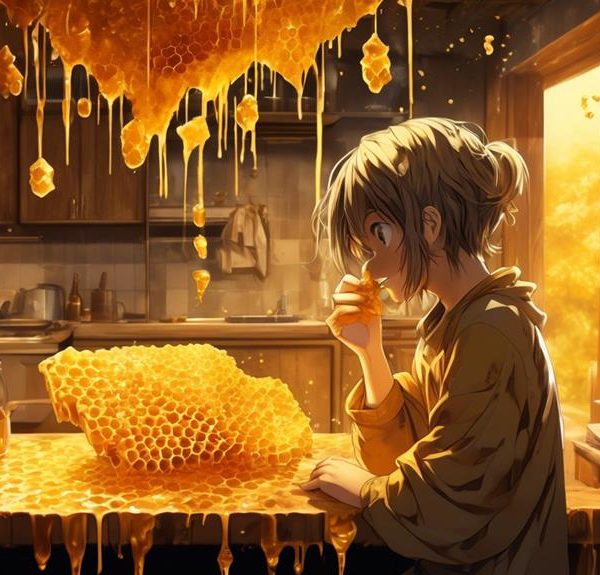Navigate the intriguing world of Bee Orchids, their deceptive allure, and the uncertain status of their protection amidst climate change and habitat loss.

Are Bee Orchids Protected?
Bee Orchids might just be the most alluring con artists in the plant kingdom. You've probably marvelled at their intricate beauty, those deceptive petals mimicking a bee to lure unsuspecting pollinators. Yet, their survival hangs in the balance.
While laws exist to safeguard certain species, the protection status of Bee Orchids is not as black and white. With the growing threats of climate change and habitat loss, you might wonder, are these deceptive beauties truly protected?
Stay tuned as we unfold this complex narrative.
Key Takeaways
- Bee orchids are listed as 'Near Threatened' by the IUCN, indicating their declining numbers and vulnerability.
- While protected under the Wildlife and Countryside Act 1981 in the UK, the enforcement of these protections is lacking.
- In the US, bee orchids are not protected as endangered species under the Endangered Species Act.
- Habitat loss, climate change, and pollution are significant threats to bee orchids and their survival.
Understanding Bee Orchids
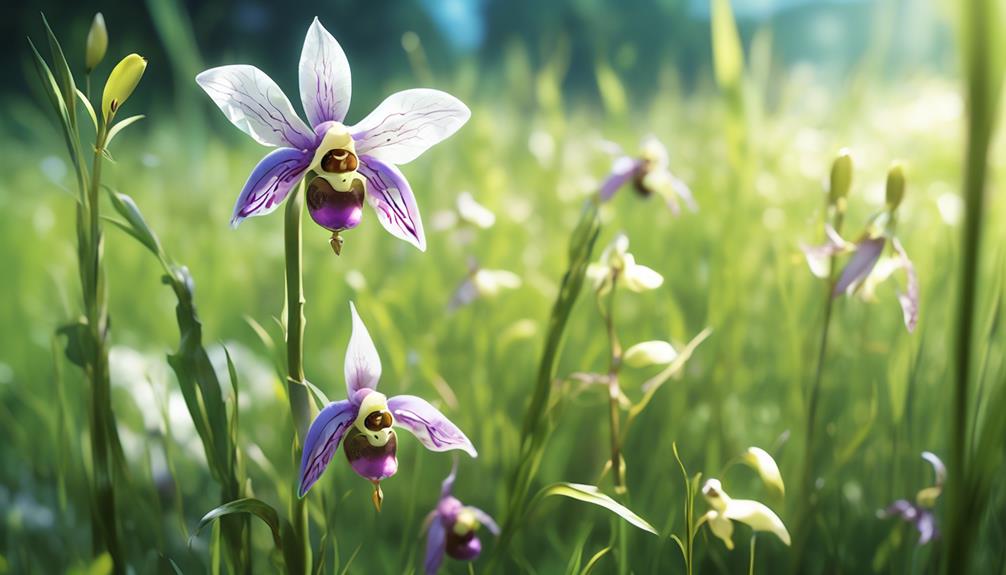
To truly comprehend the nature of bee orchids, you must delve into their unique biological features and survival strategies. Bee orchids, or Ophrys apifera, as they're scientifically known, are one of nature's greatest mimics. They've developed an extraordinary relationship with their pollinators, the male bees, by not only resembling them visually but also releasing a scent similar to female bees. This deception entices the male bees, which attempt to mate with the flower, unknowingly pollinating it in the process.
You may wonder, how does a plant achieve such a detailed mimicry? It's all down to evolution. Over thousands of years, bee orchids that resembled bees more closely were more successful in attracting pollinators and hence, reproducing. Therefore, these plants had a higher survival rate and their bee-like traits were passed on to future generations.
It's not just the deception that's fascinating. Bee orchids are also self-pollinators. If a bee doesn't fall for the ruse, the flower can still reproduce by self-fertilizing. This dual strategy ensures the survival of the species, showcasing the intricate and adaptive nature of the bee orchid's biology.
Current Status of Bee Orchids
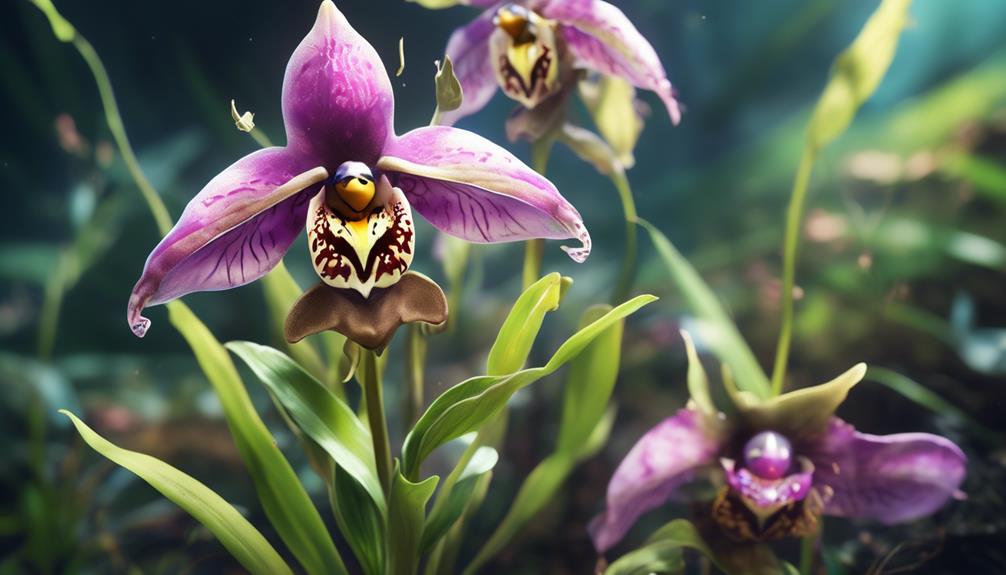
While you might be captivated by the bee orchid's fascinating survival strategies, it's crucial to delve into the current status of this species, exploring the various factors that are affecting their population and distribution globally.
Bee orchids, scientifically named Ophrys apifera, are currently facing a decline in numbers. Their fascinating mimicry, while aiding their survival, isn't enough to protect them from the threats they're encountering. Encroachment on their natural habitats due to urbanization and intensive farming practices, alongside climate change, is wreaking havoc on their existence.
They're not officially classified as endangered yet, but they're on the International Union for Conservation of Nature's (IUCN) 'Near Threatened' list. That's a step away from becoming endangered.
In the UK, they're protected under the Wildlife and Countryside Act 1981, making it illegal to uproot them. But despite this protection, their numbers continue to dwindle. The legislation doesn't prevent habitat loss, and it's not enforced globally.
Laws Protecting Bee Orchids
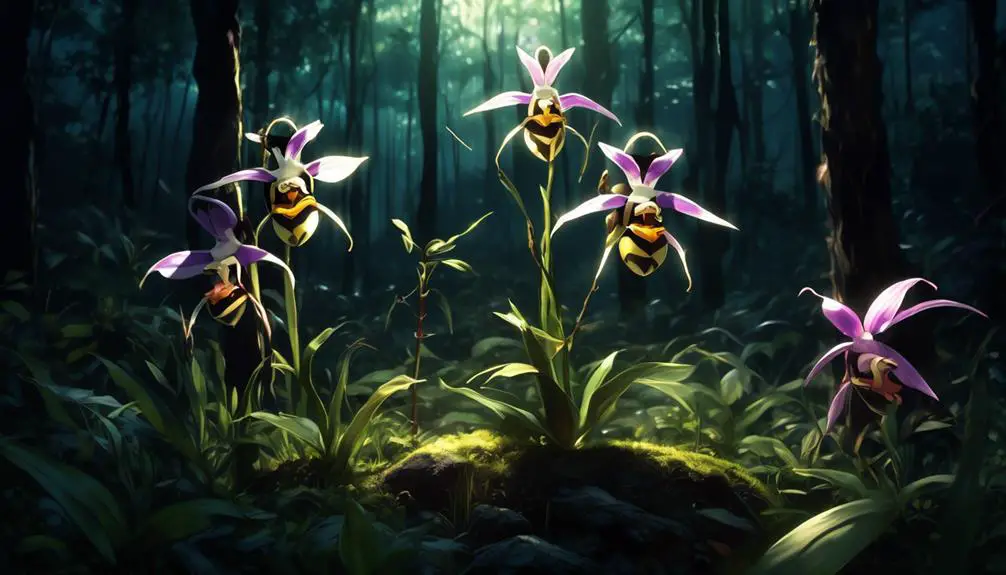
Despite the precarious situation of bee orchids, there's a legal framework in place aimed at their protection, which we'll now explore in detail. You'll find that most countries have various laws to conserve their biodiversity, and bee orchids are no exception.
In the UK, for instance, the Wildlife and Countryside Act 1981 affords protection to these unique plants. It's an offence to intentionally pick, uproot, or destroy them. Similar laws exist in Europe under the European Union's Habitats Directive. It obliges member states to maintain or restore habitats and species, like the bee orchids, at a favorable conservation status.
Now let's cross the Atlantic. In the US, the Endangered Species Act protects plants that are endangered or threatened, but unfortunately, bee orchids don't fall into these categories here. However, they're safeguarded in many states under local laws.
Yet, despite these protections, the challenge lies in enforcement. Many orchids grow in remote, hard-to-monitor areas. Also, illegal trade and habitat destruction continue to pose threats. So while the laws are there, it's up to us to ensure their effective implementation, helping these fascinating flowers flourish.
Your understanding and support are critical to their survival.
Threats to Bee Orchids
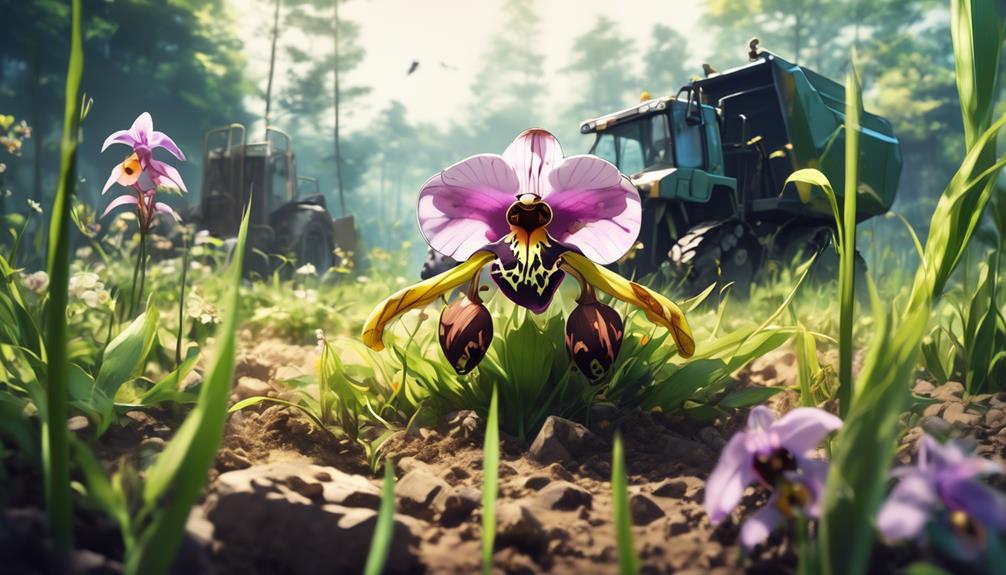
In the face of legal protection, bee orchids still grapple with a host of threats, among which habitat loss and climate change are most pressing. Your understanding of these threats is crucial for the survival of these unique plants.
Habitat loss is primarily driven by human activities. Urbanization, deforestation, and agricultural expansion are eating into the habitats of bee orchids. Each acre lost means a significant reduction in the number of plants that can grow and propagate. Remember, bee orchids aren't adaptable. They require specific habitats – usually calcareous soils. Devastatingly, once their habitat is destroyed, they're unlikely to return.
Moreover, climate change is another existential threat. As global temperatures rise, the orchids' native climates are changing, making it harder for them to survive. They're sensitive to temperature and precipitation changes. Extended periods of drought or excessively wet weather can be detrimental.
Lastly, let's not forget pollution. Chemicals used in farming and industry can contaminate the orchid's soil, affecting their growth and reproduction.
Despite legal protections, it's clear that bee orchids are under siege. Understanding and addressing these threats is your first step to help protect them.
Contributing to Bee Orchid Conservation
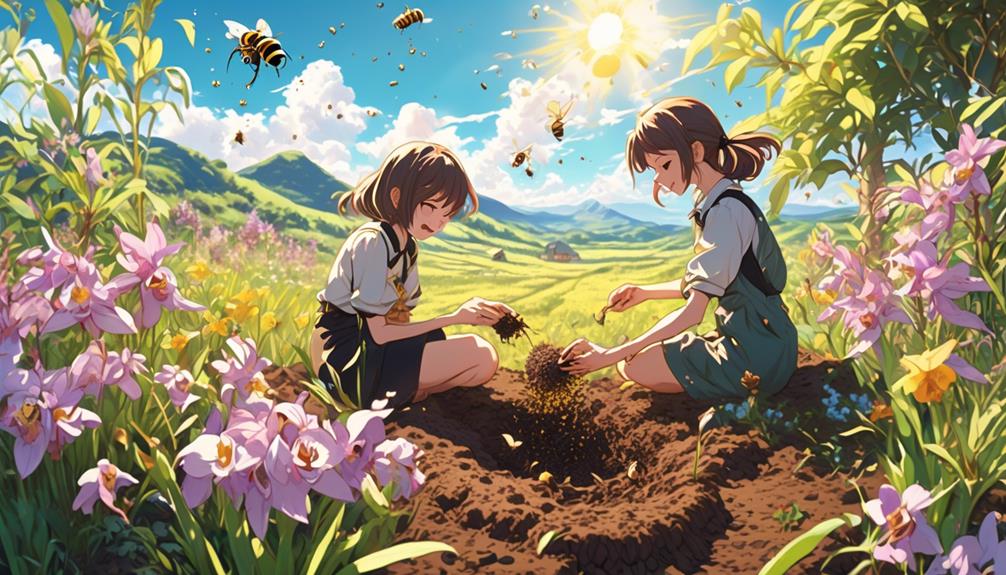
You can play a significant role in the conservation of bee orchids, a task that requires a detailed understanding of the plant's needs and a commitment to proactive protection measures. This fascinating plant requires specific conditions to thrive, including well-drained soil, ample light, and a cool, damp climate. By preserving these conditions, you'll help to ensure the survival of this unique species.
Your contribution could be as simple as planting bee orchids in your garden, provided that it offers the right environment, or supporting organizations dedicated to their conservation. Additionally, it's crucial to avoid using harmful pesticides that can damage the plant's delicate ecosystem.
Bee orchids need particular fungi to flourish, a relationship known as mycorrhizal symbiosis. You can promote this by adding organic compost to your garden. It's also important to discourage land development in areas where bee orchids grow naturally, as this destroys their habitat.
Scientific research is another key element in bee orchid conservation. By participating in or supporting studies that investigate the plant's needs and threats, you'll contribute valuable data that can guide conservation efforts. Every action counts in protecting this remarkable plant.
Frequently Asked Questions
What Is the Pollination Process for Bee Orchids?"
You're asking about the pollination process of bee orchids. It's quite fascinating!
Bee orchids release a scent that attracts male bees. Mistaking the flower for a female bee, the bee tries to mate, covering itself with pollen in the process.
When the bee visits another orchid, it unknowingly deposits the pollen, completing the pollination process.
It's an incredible example of nature's ingenuity, don't you think?
What Are the Optimal Growing Conditions for Bee Orchids?"
You're curious about the optimal growing conditions for bee orchids.
They prefer well-drained soil and locations with partial sunlight.
These orchids need a cool resting period in winter to stimulate flowering.
They enjoy a humid environment but don't like to be overly saturated.
Bee orchids also need a specific fungus in the soil to help them absorb nutrients.
It's crucial to replicate these conditions if you're considering growing bee orchids yourself.
Are There Any Known Diseases or Pests That Specifically Affect Bee Orchids?"
You're curious about diseases or pests that target bee orchids. Well, these flowers aren't often troubled by diseases, although fungal infections can occur.
Pests, on the other hand, can be a problem. Slugs and snails are common culprits, as they're attracted to the plant's succulent leaves. Aphids may also pose a threat.
To protect your orchids, it's essential to maintain clean growing conditions and monitor for signs of these pests.
How Do Bee Orchids Contribute to Their Ecosystem?"
You're delving into the role bee orchids play in their ecosystems.
These unique flowers mimic female bees, luring male bees to 'mate' with them. This clever trick aids in the orchid's pollination.
Additionally, their nectar provides food for the bees.
Thus, bee orchids contribute to their ecosystem by ensuring their own survival and providing sustenance for bees.
This bolstering of the bee population is crucial for pollination of many other plants.
Can Bee Orchids Be Grown Domestically, Such as in Home Gardens or Greenhouses?"
Yes, you can grow bee orchids domestically in either a home garden or greenhouse. However, it's not an easy task. These orchids require very specific conditions to thrive. They need well-draining soil, high humidity, and cool to intermediate temperatures.
It's also important to mimic their natural light conditions. Keep in mind, they're self-pollinating, so you won't need bees.
But remember, you're dealing with a delicate species, so handle with care!
Conclusion
So, are bee orchids protected?
Yes, they are. However, with threats like habitat loss and climate change, their survival is precarious.
Legal protections exist, but they're not always enough. It's up to us to contribute to their conservation, ensuring these unique plants continue to thrive.
Remember, every action counts, even small ones. By understanding and respecting the natural world, we can help preserve the fascinating bee orchid for future generations.


